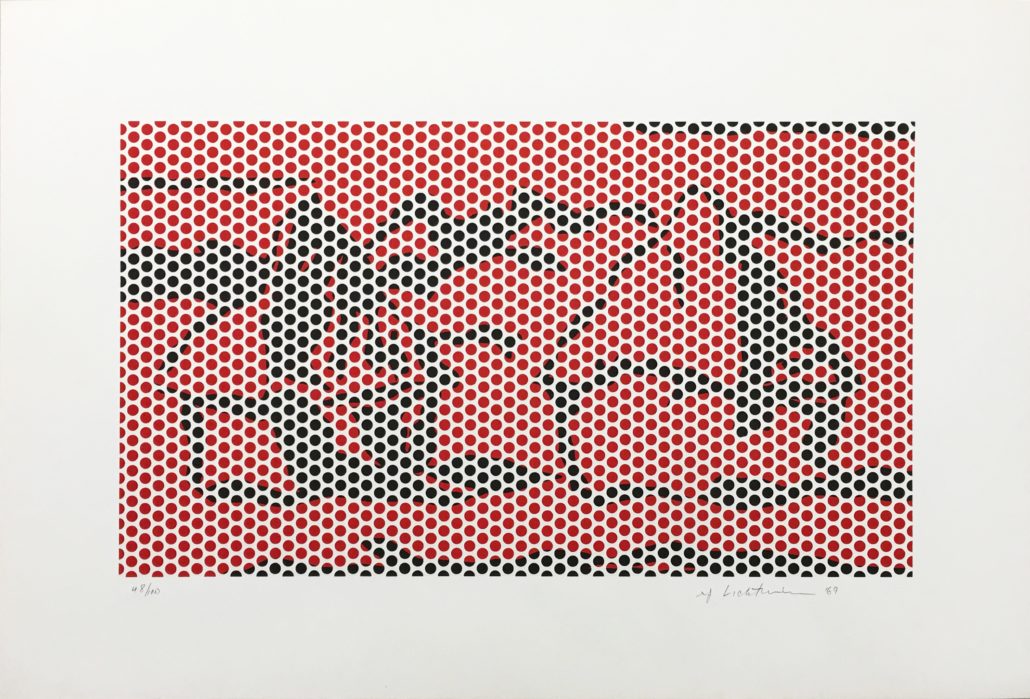
Haystack #2, 1969, Lithograph and screenprint on Rives BFK paper”
Roy Lichtenstein: A Review
“I think that most people think painters are kind of ridiculous, you know?” – RL
Roy Lichtenstein was not like most people, and he certainly didn’t think painting was a ridiculous profession. Up until the end of his life at age 73, he often spent ten hours a day working in his studio. Alongside the ranks of Andy Warhol and Jasper Johns, Lichtenstein achieved great fame and success during his lifetime. He was an original pioneer of Pop Art in the 1960s.
Over his long career, he produced famous works like Drowning Girl, Whaam! and Look Mickey are regarded as his most influential works. His most expensive piece is Masterpiece, which sold for $165 million in January 2017.
Here’s a video from the Tate Modern, a contemporary art museum in London. It portrays and describes several of Lichtenstein’s works, as well as his influences, motives, and his use of the famous Ben-day dots. Then read on for more facts that you might not know about Roy Lichtenstein.
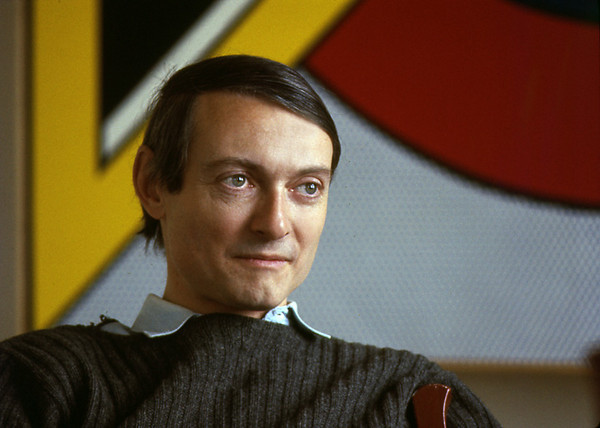
Headshot of Roy Lichtenstein with a Backdrop of His Work
10 Facts About Roy Lichtenstein You Didn’t Know
1. His life was a full circle journey.
Roy Lichtenstein was born in the city so nice, they named it twice; New York, New York. Like many other artists, Lichtenstein found that the Big Apple had an irresistible magnetism.
After graduating from a preparatory school on the Upper West Side, he left NYC to pursue a degree in fine arts at the Ohio State University. World War II broke out and interrupted his studies, carrying him across the Atlantic where he traveled with the army to England, France, Belgium, and Germany.
He completed further study in Columbus and a brief teaching post at OSU before moving to Cleveland. With time, he inched closer and closer to his hometown. First, he moved to upstate New York to teach at SUNY Oswego, then landed a teaching post at Rutgers in New Jersey before finally heading back across the Hudson River to Manhattan.
2. You can measure his artistic prominence by his proximity to NYC.
Interestingly, there is a strong parallel during his adult life between his distance to New York City and his success as an artist. While in Europe, his commanding officer promoted him from an orderly to a draftsman. In other words, he drew for the Army.
At SUNY Oswego, he broke away from representation to an entirely abstract style and began embedding comic-book characters figures such as Mickey Mouse and Donald Duck in brushy, expressionistic backgrounds. Then at Rutgers, surrounded by influential colleagues, he stepped into his power as an artist. He produced Look, Mickey and never looked back. He resigned his teaching post at Rutgers and moved up to the major leagues.

New York City was the place of Lichtenstein’s birth and death.
3. Look, Mickey was inspired by a challenge from Lichtenstein’s son.
As he read a Mickey Mouse comic book to his son, the boy said; “I bet you can’t paint as good as that, eh, Dad?” We don’t know if Lichtenstein replied with, “Eureka!”, but the Aha! moment did prove seminal.
He took Mickey character with its hard edges and Ben-Day dots and blew up the size, creating a work that forced 1960s New York to stop and think. In the same year, he produced six other works with recognizable cartoon characters. The dots became a trademark forever identified with Lichtenstein and Pop Art.
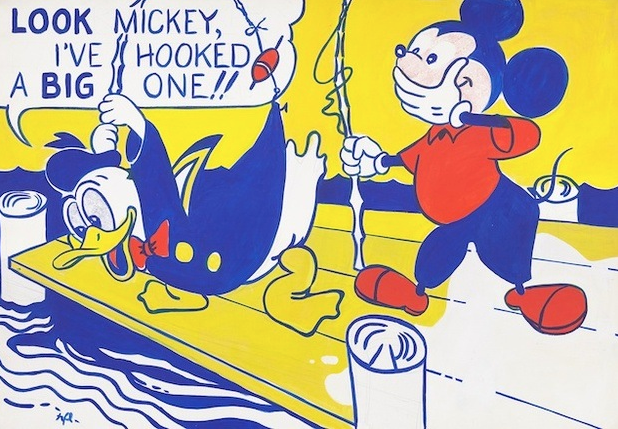
Look, Mickey may not exist apart from the chiding of Lichtenstein’s son.
4. In 1962, Lichtenstein beat out Warhol and Rosenquist.
This is one of the least well-known facts about Roy Lichtenstein. In the 1960s, Leo Castelli was the man artists wanted to impress. He was New York’s leading dealer in contemporary art. For rising stars like Andy Warhol, James Rosenquist, and Roy Lichtenstein, he was the guy at the center of their radars.
While Warhol would go on to higher renown, Castelli chose to represent Lichtenstein first at his private gallery. The paintings sold out before the showing began. Anecdotes like these help determine his status as the proto-father of Pop Art.
5. Whaam! reflects a lifelong interest in aviation.
As a child, he often built model planes. Later he would participate in pilot training while preparing for the Second World War, although he never put it to use. Once he achieved great success later in life, he accepted a commission from the Port Columbus International Airport for a 25-foot sculpture.
His most famous painting adapts a panel of a DC comic book created by Irv Novick, who knew Lichtenstein personally. Novick was an officer at the army boot camp where Lichtenstein trained during WWII. After spotting Lichtenstein’s talent as a draftsman, Novick reassigned him to design posters.
The question remains, perhaps, whether Lichtenstein repaid the favor in full and then some by elevating the original panel into a monument of modern art or if he repurposed Novick’s craftsmanship without so much as giving an ounce of due credit.
Concerning this old dilemma of Pop Art, we might consider a pair of quotes. Andy Warhol once said, “Art is what you can get away with,” and Lichtenstein reportedly quipped, “Art doesn’t transform. It just plain forms.”
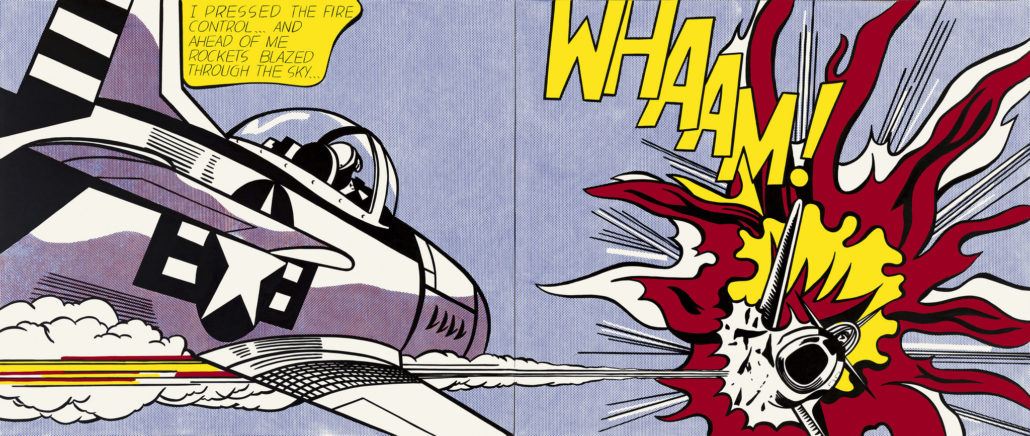
Whaam! is perhaps the most famous and controversial painting of Lichtenstein.
6. Drowning Girl and Oh, Jeff…I Love You, Too…But… reflect a lifelong interest in women.
Drowning Girl or I Don’t Care! I’d Rather Sink is often referred to as a “masterpiece of melodrama.” It draws predominately from a page from “Run for Love!” in Secret Hearts, created by Tony Abruzzo. Viewers may also see the influence of Hokusai’s famous print called The Great Wave off Kanagawa.
According to his second wife, Dorothy Lichtenstein, Roy had more female friends than male friends. She also reportedly said that he might have thought that women were generally smarter than men. He also painted a series of nude women.
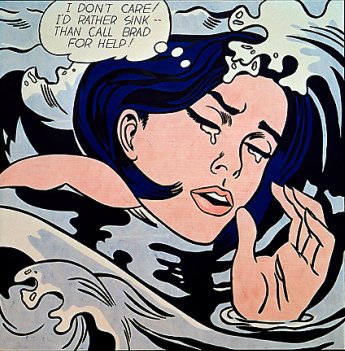
Drowning Girl or I Don’t Care! I’d Rather Sink is often referred to as a “masterpiece of melodrama”.
7. Masterpiece reflects a premonition of oncoming success.
The quote bubble leading from the shining lips of a classic American beauty reads, “Why, Brad Darling, this painting is a masterpieces/ My, soon you’ll have all of New York clamoring for your work.” The painting first appeared in a 1963 gallery show. That was before Lichtenstein had the whole city clamoring for his work.
Perhaps this helps to explain why the work recently sold for $165 million, by far his most valuable work. It also ranks among the top fifteen most expensive paintings ever sold, as of 2017.
8. His approach to art resulted in significant criticism.
From the early 1960s up until recent years, he has been raising the question of whether Lichtenstein is a great contemporary artist or merely a plagiarist. Around the time of his first substantial showings, Life magazine even published an article with the inflammatory title, “Is He the Worst Artist in the U.S.?” Viewers of his art have raised many arguments, sometimes resolved and sometimes left disputed, in the space before his paintings.
Some argue that the minor adaptations he made, such as omitting elements and blowing up the size, are inconsequential and that the lack of credit is unforgivable, even if it was part of the status quo at the time. Others argue that he endowed simple comic book panels with great vision and transformed them into a cohesive work of art.
Perhaps the only thing that you cannot dispute is just how controversial Lichtenstein was and remains. Once again, it makes sense to turn to the opinion of the artist himself, who objected to the phenomenon that one person’s drawings “was considered brilliant, and somebody’s else’s, that may have looked better to you, was considered nothing by almost everyone.”
9. Lichtenstein has worked in dozens of mediums.
While the spotlight rests on his Pop Art paintings, he contributed works of art from a vast array of media. He has worked with wood, bronze, steel, plexiglass, enamel, graphite, ceramics, and much more. Additionally, he created a film called Three Landscapes.
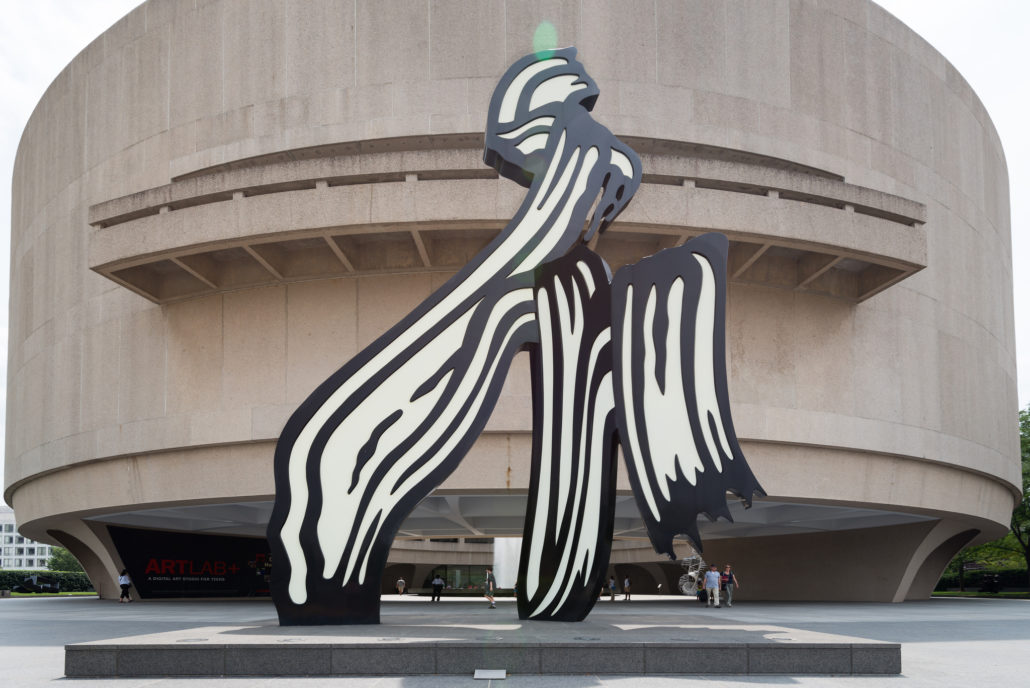
Brushstroke is Lichtenstein’s most famous sculpture, located at the Hirshhorn Museum & Sculpture Garden on the Mall in Washington, DC
10. He has been commissioned around the world.
Among his more notable commissions are the DreamWorks Records logo (which he vowed to be his first and last corporate logo), a five-story mural at the Equitable Center in New York, and painting a Group 5 Racing Version of the BMW 320i. He has also completed commissions in Amsterdam, Barcelona, Japan, and more.
For a beautiful peek at his charming sense of humor, plus the rotating easel he designed and other fun facts about Roy Lichtenstein, check out this video:

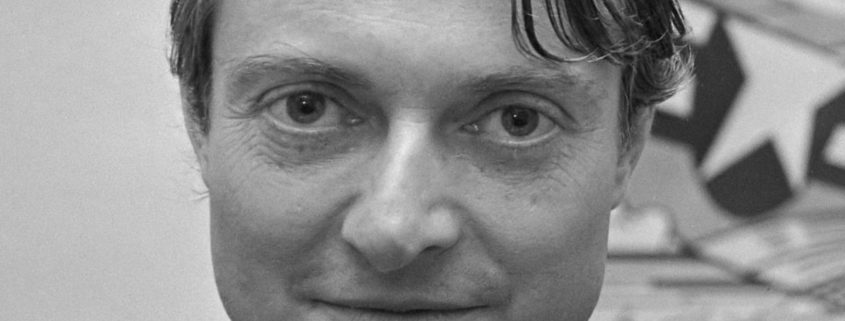



Brilliant facts!!!!! I would LOVE to see the Brushstroke sculpture m. Even my dad could not do that. Hahahah .